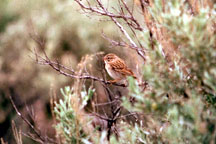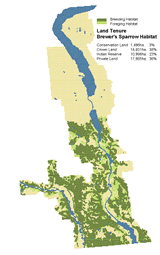|
Habitat Atlas for Wildlife at Risk
Brewer's Sparrow
Spizella breweri breweri

Brewer's
Sparrow
|

- Length: 13 cm.
- A small, pale sparrow with a plain, unstreaked
breast.
- Crown is finely streaked with no hint of a central
line.
Status:
British Columbia Red List
Special Significance
The Brewer's Sparrow may be plain in appearance but
its song is one of the most beautiful and complex
in the North American shrub-grasslands. Two subspecies
occur in British Columbia, the Timberline Sparrow
in alpine meadows in northern mountains and the sagebrush
race in sage benchlands in the South Okanagan. The
latter form is in danger of being extirpated in British
Columbia. Heavy grazing and clearing of sagebrush
for urban and agricultural development has seriously
affected the availability of suitable nesting areas.
The preservation of remaining Brewer's Sparrows depends
on the careful management of remaining large tracts
of dense sagebrush habitat. Heavy grazing of sagebrush
sites should be avoided, and areas cleared of sagebrush
should be restored wherever possible.
Distribution
- This subspecies is restricted to sagebrush rangelands south of
Penticton in the Okanagan Valley, especially Yellowlake Creek, White
Lake, Manuel's
Flats (Oliver) and Richter Pass, and in the Similkameen
Valley at Blind Creek, Chopaka Customs and Kilpoola Lake.
- A few have been seen in the Thompson Valley near Kamloops.
- Elevational range is 350 to 1800 metres.
Habitat
- Requires extensive tracts of open brush lands including sagebrush,
plains, alpine meadows, valleys with low shrubbery.
- Nests in arid sagebrush-grassland habitat; nests are
built in sagebrush and small shrubs, usually near
the ground (mean height of 30 to 49 cm).
- Birds forage in sagebrush habitat, although wetlands
and shrubby ravines may also be important insect
foraging areas during the nesting season.
Reproduction
- Birds arrive at breeding sites in late April or early May.
- Eggs are laid from mid-May to mid-June and hatch from
late May.
- Young fledge early June to mid-July.
Food Habits
- Feeds on seeds and insects, especially caterpillars, on the open
ground between and beneath the sagebrush plants.
Interesting Facts
- Musical song is a canary-like series of varied bubbling notes and
buzzy trills at different pitches.
Threats
- Loss of sagebrush habitat due to agricultural and
urban development.
- Burning and clearing of sage for range improvement.
- Heavy grazing may reduce the amount of insect
prey.
- Susceptible to pesticides in insect prey.
Management Considerations
- Avoid further removal of sagebrush for residential,
commercial and agricultural development.
- Monitor and reduce the use of pesticides.
- Restore sagebrush to areas which have been cleared
in the past.
- Avoid heavy grazing in sagebrush areas.
- Protect known nest sites from human disturbance.
|
References
1. Cannings, R.A., R.J. Cannings and S.G. Cannings. 1987. Birds of
the Okanagan Valley, British Columbia. Royal British Columbia Museum,
Victoria, BC. 420 pp.
|